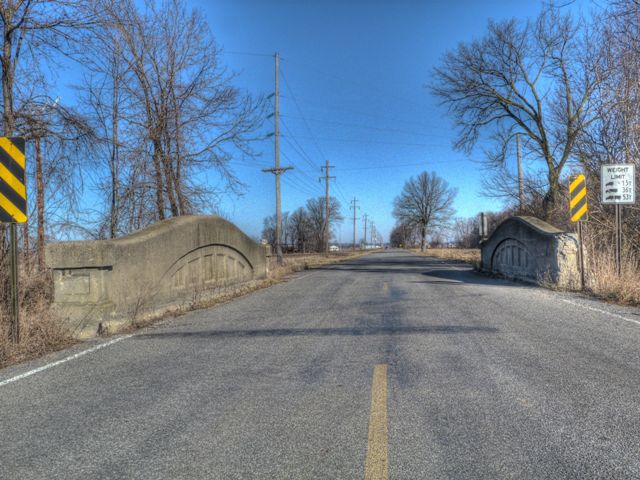We Recommend:
Bach Steel - Experts at historic truss bridge restoration.
BridgeHunter.com Phase 1 is released to the public! - Visit Now
2nd Street Bridge North

Primary Photographer(s): Nathan Holth
Bridge Documented: December 26, 2011
Rural: Allegan County, Michigan: United States
1926 By Builder/Contractor: Unknown and Engineer/Design: Michigan State Highway Department
Not Available or Not Applicable
48.0 Feet (14.6 Meters)
50.0 Feet (15.2 Meters)
22 Feet (6.71 Meters)
1 Main Span(s)
03200086000B020

View Information About HSR Ratings
Bridge Documentation
This bridge no longer exists!
View Archived National Bridge Inventory Report - Has Additional Details and Evaluation
This bridge was demolished and replaced in 2014 under Local Bridge Program!
Learn about Michigan's Unique Concrete Camelback Bridges
This bridge is one of two nearly identical curved chord through girders on 2nd Street in Allegan County. They both cross the same river too. As such, the two bridges form a small "group" of historic structures. So many bridges of this type have been demolished in Michigan that it is rare today to find two examples of this bridge type so close together. The bridge is today in relatively good condition. It remains in a condition where preservation is feasible. With concrete bridges, it is better to schedule rehabilitations before deterioration becomes advanced, so the time to plan for a rehabilitation of this bridge should be now. Instead however, Allegan County Road Commission is intent on spending large amounts of money to demolish and replace this historic bridge with a slab of concrete. It is sad that a county that has found outstanding ways to preserve two highly significant metal truss bridges should ironically fail so miserably to preserve its concrete historic bridges.
Photos below from the Allegan County Road Commission show the demolition of this historic bridge.
Michigan's Concrete Camelback Bridges
All of Michigan's surviving curved chord through girders should be considered historically and technologically significant. The bridges are historically significant because they represent a unique and innovative design developed by the Michigan State Highway Department in its earlier years of bridge construction.
The bridges should be considered technologically significant as well. By incorporating a curve into the design, Michigan State Highway Department not only increased the efficiency of the design, they also greatly increased the aesthetic value of the bridges. The graceful curves of this bridge type, complemented by architectural details such as inset rectangles make them among the most aesthetically pleasing of bridge types ever encountered. Straight chord through girder bridges are generally considered among the more plain and less visually appealing types of historic bridges. The aesthetic qualities of the curved girder bridge, those qualities being an integral and functional part of the bridge and not a decorative facade, should be considered to be a technologically significant feat: an extremely effective union of function and form.
Statewide, very few examples of this bridge type have been preserved or have evidence of a preservation commitment. Further, the number of examples of this bridge type have been dropping rapidly over the years. Considering that in recent years, Michigan has begun to emerge as a leader in truss bridge preservation, it is reasonable to consider concrete camelback bridges to be the most threatened type of historic bridge in Michigan.
The bridge type has become rare through attrition in Michigan, and the rarity of the bridges today only adds to the significance of those remaining examples.
![]()
Photo Galleries and Videos: 2nd Street Bridge North
Bridge Photo-Documentation
Original / Full Size PhotosA collection of overview and detail photos. This gallery offers photos in the highest available resolution and file size in a touch-friendly popup viewer.
Alternatively, Browse Without Using Viewer
![]()
Bridge Photo-Documentation
Mobile Optimized PhotosA collection of overview and detail photos. This gallery features data-friendly, fast-loading photos in a touch-friendly popup viewer.
Alternatively, Browse Without Using Viewer
![]()
Randy Mulder Bridge Photo-Documentation
Original / Full Size PhotosAn additional collection of overview and detail photos, taken by Randy Mulder June 30, 2010. This gallery offers photos in the highest available resolution and file size in a touch-friendly popup viewer.
Alternatively, Browse Without Using Viewer
![]()
Randy Mulder Bridge Photo-Documentation
Mobile Optimized PhotosAn additional collection of overview and detail photos, taken by Randy Mulder June 30, 2010. This gallery features data-friendly, fast-loading photos in a touch-friendly popup viewer.
Alternatively, Browse Without Using Viewer
![]()
Maps and Links: 2nd Street Bridge North
This historic bridge has been demolished. This map is shown for reference purposes only.
Coordinates (Latitude, Longitude):
Search For Additional Bridge Listings:
Bridgehunter.com: View listed bridges within 0.5 miles (0.8 kilometers) of this bridge.
Bridgehunter.com: View listed bridges within 10 miles (16 kilometers) of this bridge.
Additional Maps:
Google Streetview (If Available)
GeoHack (Additional Links and Coordinates)
Apple Maps (Via DuckDuckGo Search)
Apple Maps (Apple devices only)
Android: Open Location In Your Map or GPS App
Flickr Gallery (Find Nearby Photos)
Wikimedia Commons (Find Nearby Photos)
Directions Via Sygic For Android
Directions Via Sygic For iOS and Android Dolphin Browser
USGS National Map (United States Only)
Historical USGS Topo Maps (United States Only)
Historic Aerials (United States Only)
CalTopo Maps (United States Only)





